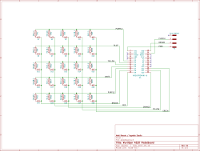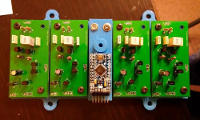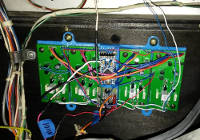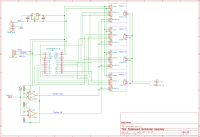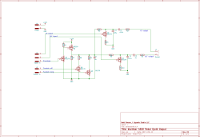Wurlitzer 4500 pedal rework
When I made my initial repairs of the Wurlitzer I was only able to address some of the problems with the pedals. The pedals operate with the help of a magnet on the end of each pedal, which closes a reed switch when the pedal is depressed. Some of the reed switches were broken; at some point, someone had tugged on the wire bundle coming from the pedalboard hard enough to pull the contact out of the end of some of the reed switches. Replacing those broken switches was easy. Luckily they still make magnetic reed switches in the exact same size.
Even after those mechanical repairs some pedals still didn't play and others sounded wrong when they did. The pedalboard is interesting. It uses two frequency dividers to lower the notes produced by the pedals by two octaves. But it only has two frequency dividers, so it has to be monophonic -- only one note at a time can be connected to the dividers. There is a pedal latch circuit that does something clever with a 220 VDC power supply and neon indicator lamps to allow only one note's signal through, even if multiple pedals are pressed simultaneously.
This latch circuit defeated me. I could see multiple lamps lit, even with no pedals pressed, which I knew was wrong. But I couldn't figure out what the root problem was. Maybe all the lamps needed replacement, maybe something else was broken as well. I didn't want to spend time and money replacing components willy-nilly without understanding what was going on.
In the end, I decided to replace the pedal circuitry entirely. I'd like to MIDIfy this organ, if I can do it in a way that still lets the organ have its original sound. The pedals are a good starting point for the effort, because they're a nice, self-contained system that doesn't tie in to every other system in the organ. My replacement would have two parts: an input segment on the pedalboard that would generate MIDI messages, and an output segment in the organ that would generate tones in response to those messages and feed them into the pedal STRAF. The STRAF units are mostly responsible for the organ's distinctive sound. I definitely want to keep them in place, but I think I can change things in the signal path leading up to the STRAF units without changing the organ's sound as long as the inputs to the STRAF units are mostly the same.
Pedalboard
I first tackled the pedalboard itself, which proved to be fairly straightforward. Originally it had a bundle of 26 wires (one wire per pedal plus a common rail) going to the organ, which was connected with three circular connectors. There were no electronic components on the pedalboard, just the wires and the reed switches. I re-wired the switches into a five-by-five matrix and connected them to the digital inputs of a Arduino Pro Mini microcontroller. I programmed the Arduino to scan the switches every millisecond or so and send a MIDI note on or off message from its serial port when it detected a change in a switch. I 3D printed a mount for the Arduino to hold it in place near the end of the pedalboard.
This setup required only three wires connecting the pedalboard to the organ -- power in, ground, and serial out (from the pedalboard to the organ). One of the three original connectors between the pedalboard and organ had three wires, so I kept that one and removed the other two connectors. In all, I took most of the wire out of the pedalboard and replaced it with one neat little microcontroller. So far, so good!
Pedal synth
The original pedal latch circuits would pass one signal from the tone generators through two frequency dividers arranged in series. The outputs from the frequency dividers then passed through sustain circuits and were capacitively coupled to the pedal STRAF inputs. This arrangement made it easy to match the behavior of the original circuits -- the outputs from the dividers were essentially square waves, and the sustain circuits were simple and easy to understand from the original schematics.
So, inside the organ, I programmed another Arduino Pro Mini to be a synthesizer. It responds to MIDI note on and off messages coming from the pedalboard and generates square waves of the proper frequency. I also duplicated the sustain output circuitry from the schematic on a custom PCB. With the current arrangement, when the synth recieves a MIDI note on message it must produce two output notes, one an octave lower than the other, to feed to the STRAF unit's 8' and 16' inputs. The pedals have both 8' and 16' stops and the stop tabs for the pedals connect to the STRAF unit, so the synth doesn't know what stop tabs are active and must therefore always produce both the 8' and 16' signals for each note.
At this point I looked at all the unused pins on the Arduino and decided to try upgrading the pedals by making them polyphonic. I added three more sustain circuits and wired them to the Arduino as well. Each circuit takes three inputs from the microcontroller: an 8' tone, a 16' tone, and an envelope signal. The tones are each routed through their own sustain circuit to the respective inputs of the pedal STRAF, and the envelope signal activates the sustain circuit. (When a note is released the envelope signal goes inactive, but the synth continues playing the tones for a while in case sustain is turned on.) Since the outputs of the sustain circuits are capacitively coupled I was able to just connect them together and to the STRAF inputs.
The pedal sustain stop tabs on the organ just connect a single input to ground through different resistors. I connected that input to the regulated 5 VDC supply from the Arduino, then was able to use a couple of op-amps to generate high or low signals corresponding to when the sustain stops were selected. Those signals were routed directly to the sustain circuits; there was no need to pass them through the microcontroller.
Also in this assembly is a linear voltage regulator that takes the 16V input to the original pedal latch circuit and converts it to 12V. That's high enough to use in the sustain circuits but low enough for the onboard voltage regulators in the Arduinos to handle. I 3D printed some brackets to hold everything together.
You might notice, in the photos below, that there are a whole lot of wires running between a few different boards. Well, prior to this project I hadn't designed a PCB in a few years, and I was using new-to-me software (KiCad) and a new-to-me PCB vendor, so I kept the boards simple. I also kept the components well spaced out and used through-hole components, because I wasn't very confident that my design would work and I wanted plenty of space to replace components or rework things. In the end, the boards worked just fine the first time. I do wish I had packed the components closer together; I think I could have gotten everything onto a single board, including headers for the Arduino, and saved myself a lot of wiring!
The pedal synth works well, but it is missing a couple of features: because it does not take its signals from the tone generators, the slide and vibrato controls don't have any effect on it. Fixing this would require routing the slide and vibrato biases from the upper amplifier to the pedal synth, then the Arduino would have to measure those voltages and adjust the period of its notes accordingly. This should be possible -- there are spare wires in the pedal's power cable to carry those signals and the Arduino's built-in DAC should be up to the task. I am concerned, though, that the Arduino wouldn't have enough processing power or that the DAC's output would be noisy because of all the digital switching happening on other pins. It's on my to-do list to try implementing that, but I'm not making it a priority currently.
Also missing are outputs to the ssh-boom circuits. The pedals are supposed to be able to activate drum and cymbal sounds from the ssh-boom, but I haven't made those connections and I haven't decided how to go about doing it. With the organ in its current state, I should make appropriate interface circuits and have the pedal synth's Arduino activate them. But, again, I'm worried about overloading that Arduino. I'm also not quite sure I understand how the interface should work. In the long term, if I convert the organ to MIDI completely, all of the inputs to the ssh-boom will need to come from MIDI signals, so maybe I should install a dedicated microcontroller for that instead.


